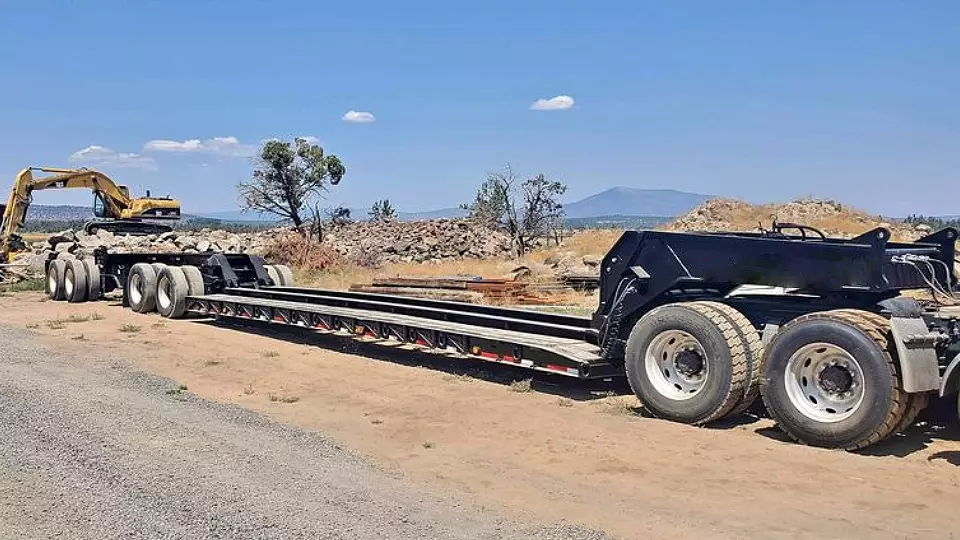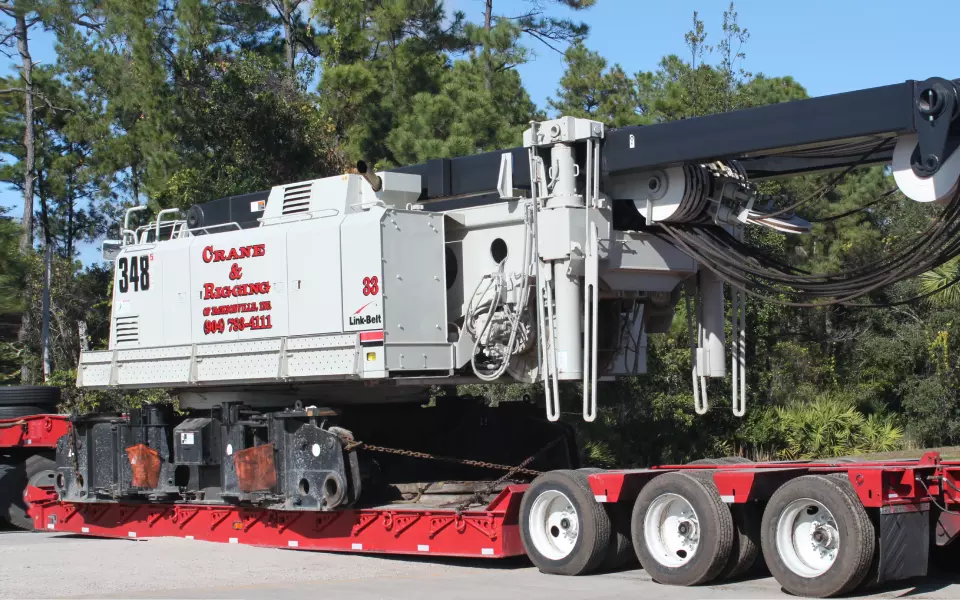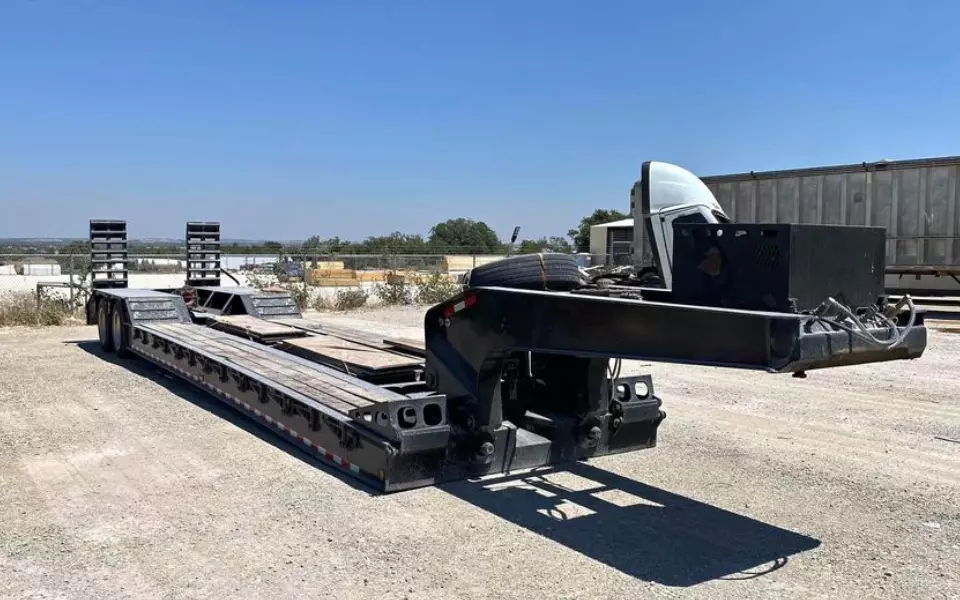Transporting heavy and oversized cargo presents significant challenges for truckers due to the weight and dimensions of the load. Fortunately, truck and equipment manufacturers have developed several specialized semi-trailers to address these transportation challenges.
One type of semi-trailer that is used to transport these loads is called lowboy trailers (sometimes referred to as double drop deck trailers). A lowboy trailer features two drop-down points (hence, the name double drop) into an open deck level sitting below the wheel height, allowing truckers to legally transport taller and wider cargo.
Popular types of cargo that are transported on lowboy trailers include construction equipment like excavators and bulldozers, power transformers, machinery, oversized vehicles, and even modular homes.
In this article, we’ll discuss lowboy trailers in detail, and explore their dimensions, specifications, and capacities. We’ll also share some of the key advantages and disadvantages and how they compare with other popular semi-trailer types in the industry.
What Is a Lowboy Trailer?
A lowboy trailer is a popular type of semi-trailer used for hauling oversized, irregularly shaped, and extremely heavy cargo. As mentioned earlier, lowboy trailers feature a lower deck or a well.
This lowest deck is designed to sit below the wheel’s height to offer sufficient ground clearance while maximizing cargo height allowance. The ground clearance of double drop trailers is between 1 to 2 feet.

Therefore, this type of trailer requires a slightly higher deck at the rear end in order to clear the wheel height. While this design offers great benefits, it also limits cargo-hauling versatility for truckers due to the deck height difference.
The front end of the trailer has an elevated structure for its kingpin to lock into the tractor’s fifth wheel. The industry commonly refers to it as the trailer’s upper deck or gooseneck.
To summarize, a lowboy trailer has a configuration of three open decks or two open decks with a connecting neck. This is also the reason why many truckers call it a double-drop deck trailer.
Their clever design makes them a valuable asset in the modern trucking industry and the go-to choice for hauling heavy cargo that cannot be transported using standard trailers, due to height or weight restrictions.
Moreover, lowboy trailers feature multiple tie-down points to secure cargo during transit. Some variations are also equipped with dove-tail and ramps for easier rear loading and unloading capabilities.
Lowboy Trailer Variations
Lowboy trailers come in different design variations that each offer a unique set of benefits. Below, we share more insights about the most common ones.
Fixed Neck Lowboy
A fixed-neck lowboy features an elevated deck at the trailer’s front and can be used to transport smaller cargo. It’s also the lightest configuration of the trailer type since it has no hydraulic or mechanical mechanisms. The fixed neck design allows loading from the sides and the back provided truckers install a ramp.
Folding Gooseneck Lowboy
Also known as a fixed gooseneck (FGN), this trailer variation is equipped with a foldable, non-detachable frontal section that creates a flat ramp on the front. Truckers looking for easier loading and unloading can opt for this trailer as it has the capability to be loaded from all directions.
Removable Gooseneck Lowboy
A removable gooseneck (RGN), is a detachable version of a fixed gooseneck. It features a mechanical or hydraulic mechanism allowing truckers to easily remove it from the main trailer for efficient loading and unloading from the front, aside from the back and sides.
Due to its specialized design, the RGN can handle heavier cargo loading from the front. For instance, heavy machinery operators can drive up onto the lower deck through it.
Extendable Lowboy
As the name suggests, an extendable lowboy trailer can be extended to transport longer cargo, such as wind turbine blades, lumber, utility poles, industrial machinery, railcar bodies, etc.
How Are Lowboy Trailers Loaded and Unloaded?
As lowboy trailers are similar to flatbed or step-deck trailers with an extra lower deck, they have a similar loading and unloading process. Below is a step-by-step guide for loading and unloading cargo of lowboy trailers.

- Inspect Cargo before Loading – Truckers and handlers must ensure the cargo is properly packaged or prepared according to safety standards and industry regulations.
- Safely Position the Trailer – The trailer must be parked in a level and secure area. Truckers and handlers should check the surroundings to ensure no obstructions or hazards could affect the process. They also need to check for sufficient space to load heavy or oversized cargo.
- Prepare the Trailer (Optional) – Trailer preparation only applies to removable and fixed gooseneck lowboy trailers. For frontal loading, use the gooseneck’s hydraulic or mechanical mechanism to lower the fixed gooseneck. For removable goosenecks, detach and move them away from the trailer to make room for loading cargo from the front.
- Load the Trailer – It’s important that the right type of handling equipment is used for loading the trailer. For instance, a crane is typically used for heavy cargo, whereas forklifts are used for oversized and palletized cargo. Removable gooseneck lowboys have a ramp that allows heavy machinery or vehicles to be driven straight onto them.
- Secure the Cargo – Once the cargo is loaded, inspect its position vigilantly and ensure its weight is properly distributed. Finally, secure the cargo with cables, straps, chains, and similar, using the tie-down points on the trailer.
- Unloading the Trailer – Following the transit and arrival at the final destination, all tie-downs should be removed. Folding Gooseneck Lowboys need to be lowered and Removable Gooseneck Lowboys need to be disconnected if applicable. Once completed, cargo can be unloaded cargo using the proper equipment.
Lowboy & Double Drop Deck Trailer Dimensions & Capacity
A standard lowboy trailer is between 24 to 29.6 feet long and 8.5 feet wide. They also have an extremely low ground clearance, usually between 1 to 2 feet, compared to a standard flatbed or step-deck trailer that has a ground clearance ranging between 3 to 5 feet.
Lowboy trailers have a capacity range between 40,000 and 80,000 lbs depending on the number of axles in their configuration. Therefore, they’re ideal for heavy and large cargo, where extra height clearance is crucial.
Cost of a Lowboy or Double Drop Deck Trailer
Lowboy trailers are among the most expensive types of semi-trailers in the industry due to their versatile design and weight capacities. On average, a brand-new lowboy trailer can cost anywhere between $65,000 and $160,000 depending on the model, configuration, and manufacturer.
Specialized or heavy-duty models with more durability and advanced features can easily exceed $160,000, depending on the demand and market. On the other hand, used lowboys are less expensive and usually range between $5,000 to $100,000, depending on their age, condition, and specifications.

Before purchasing a lowboy trailer, it’s important to thoroughly assess the hauling requirements and conduct proper market research. You can consult with different dealerships, private sellers, and other trucking companies about the costs involved.
When choosing between new and old trailers, understand the pros and cons of each option. For instance, new trailers have no wear and tear. Depending on the make and model, they may offer better features, such as enhanced durability and a modern hydraulic mechanism.
Conversely, used lowboys are more budget-friendly and ideal for truckers starting as owner-operators. Leasing lowboy trailers is another viable option, especially for truckers with short-term needs.
Leasing can cost anywhere from $300 to $500 a day or $1,200 to $4,000 a month based on various negotiable factors such as leasing period, repair and maintenance arrangements, model, and condition among others.
By renting or leasing, carriers and owner-operators can scale their fleet for a specified duration without having to invest large amounts of capital. However, high demand and low supply in saturated markets can make leasing an expensive and unreliable option.
Types of Cargo Hauled by Lowboy Trailers
As mentioned earlier, lowboy trailers are designed for transporting specific types of cargo, which we’ll further explore in this section.
- Agricultural Machinery – The agriculture industry leverages lowboy trailers to transport heavy-duty tractors, harvesters, irrigation systems, grain carts, and more, to and from farms and processing facilities in rural areas.
- Construction Materials – The construction industry relies heavily on double drop deck trailers to transport essential overweight or oversized components and materials, including steel beams, pipes, concrete forms, prefabricated structures, and lumber, among various others.
- Heavy-Duty Equipment – Lowboys are ideal for transporting large tractors, cranes, boilers, transformers, tanks, generators, and other heavy-duty equipment across vast distances.
- Marine Parts & Equipment – The maritime and ocean transport industry leverages lowboy trailers to transport boats, engines, ship propellers, and large vessel construction parts.
- Aircraft Components – Aircraft components can easily weigh thousands of pounds and are usually irregularly shaped and taller than general cargo. Hence, the industry uses lowboys to transport wing parts, fuel tanks, turbines, landing gears, and more.
- Oversized Cargo – Oversized cargo is any good or equipment that exceeds standard dimensions or weight limits set by the US Department of Transportation. It typically includes military equipment, industrial parts, modular homes, oversized vehicles, and more.
Advantages of Lowboy Trailers
Below, you’ll find some of the key advantages of lowboy trailers that carriers, shippers, and receivers typically benefit from.
- Superior Transportation Capabilities – The lower deck of a double drop deck trailer is just 1 to 2 feet off the ground. Therefore, it has an extremely low ground clearance, which allows it to transport tall cargo (up to 12 ft) without violating DOT regulations. Truckers can also attach multiple axles to increase their weight capacity when transporting extreme loads.
- Easy Loading and Unloading – Lowboys with fixed or removable goosenecks can enable loading and unloading from any direction of the trailer. The lower deck’s height from the ground makes it easier for cranes and forklifts to move cargo on and off the trailer.
- Cargo Specialization – Lowboy trailers are the most specialized flatbed trailers in the industry. They can transport cargo that most other trailer types are not able to, especially heavy machinery and industrial equipment.
- Improved Stability – The trailer’s extremely low ground clearance reduces the center of gravity and wind resistance, making it less prone to accidents than most semi-trailer types.
Disadvantages of Lowboy Trailers
Like most semi-trailers, lowboys are not without a few drawbacks. We highlight some of the main drawbacks below.
- Higher Costs – Lowboys feature a complex design that allows them to transport cargo most trailers can’t. This unique selling proposition and other features like goosenecks make them more expensive than most semi-trailers. The low ground clearance makes the lowest deck more vulnerable to damage and difficult to access for repairs and maintenance, which only adds to the costs.
- Regulation and Competency Barrier – Truckers may require special permits to perform heavy haul operations using lowboys, depending on the cargo type and size. Due to complicated weight distributions, they could also struggle to comply with weight station requirements. Furthermore, securing oversized or irregularly shaped cargo requires strategic planning and more vigilance.
- Shorter Trailer Length – Since lowboy trailers are divided into three decks, the segregation limits the maximum cargo length. Secondly, lowboys are typically 24 to 29.6 feet long. In contrast, flatbed, intermodal, and reefer trailers can be up to 53 ft.
- Lower Mobility – Carriers offering heavy haul services must manage longer delivery times than standard operations. Oversized or overweight cargo is more difficult to handle (load and unload). More importantly, drivers have to operate their trucks at slower speeds, especially on narrow roads.
Lowboy Trailer Comparisons
Double drop deck trailers are one of many semi-trailer types truckers use to transport heavy and oversized cargo types. We have received frequent questions regarding the difference between these trailers against flatbed, step-deck, and removable gooseneck trailers. Let’s explore the key similarities and differences below.
Lowboy Trailers (Double-Drop Deck) Versus Flatbed Trailers
While lowboy trailers are a type of flatbed trailer, this section will elaborate on the comparison between lowboy trailers and conventional flatbed trailers. Both flatbed and lowboy trailers excel at transporting diverse cargo across vast distances.
They also provide tie-down points to secure cargo during transit. However, the key differences between these trailers are deck segregation and ground clearance. Lowboy trailers have two drop levels, with the lowest deck below the wheel height.
This design enables lowboys to transport taller cargo, making it more versatile than conventional flatbeds, which can only carry loads within standard height limits. Lowboy trailers are generally more expensive than regular flatbed trailers due to their versatility and additional features.
Their innovative design also reduces the center of gravity, enhancing stability and reducing the risk of accidents.
Lowboy Trailers (Double-Drop Deck) Versus Step Deck Trailers
Lowboys and step-deck trailers are both open-deck flatbed variants with different deck levels. Hence, they offer the same benefits, such as decreasing the trailer’s center of gravity to improve stability when transporting heavy loads.
They also transport the same types of cargo. The key difference lies in the number of deck segments and the overall loading capacity. Step-deck trailers have two, while lowboys have three – a gooseneck/upper deck, a well (the lowest deck), and a rear deck above the wheels.
Therefore, lowboy trailers can carry taller cargo (usually about 1.5 to 2 feet taller). Additionally, lowboy trailers can be easily configured to have additional axles allowing them to haul heavier loads.
In terms of cargo handling, step-deck trailers only allow loading and unloading from the back and sides. In contrast, foldable or removable goosenecks also allow loading and unloading from the front.
Lowboy Trailer (Double-Drop Deck) Versus Removable Gooseneck Trailers (RGN)
Removable gooseneck trailers are a variation of lowboy trailers, as explained in the previous sections. Although they feature the same basic design, the key difference lies in their ability to detach from the trailer. This is something other traditional lowboy variants aren’t able to do.
This unique feature allows removable gooseneck trailers to attach additional axles to haul extremely heavy loads and comply with weight distribution regulations. They also have a hydraulic mechanism that simplifies and automates the lowering and detaching process.

Get Free Course Access
If you enjoyed the article, don’t miss out on our free supply chain courses that help you stay ahead in your industry.

Andrew Lin
Co-Founder & Writer
at freightcourse
About the Author
Andrew is a multi-business owner with over 12 years of experience in the fields of logistics, trucking, manufacturing, operations, training, and education.
Being the co-founder of freightcourse has given him the ability to pursue his desire to educate others on manufacturing and supply chain topics.
Follow us